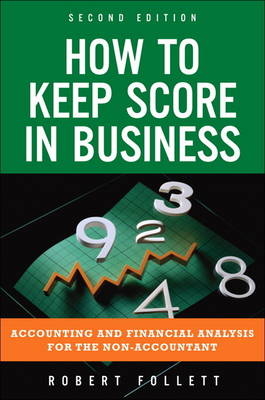
How to Keep Score in Business
Financial Times Prentice Hall (Verlag)
978-0-13-284925-8 (ISBN)
- Titel ist leider vergriffen;
keine Neuauflage - Artikel merken
Long-time CEO Robert Follett shows you exactly how to "keep score" in business by reading and interpreting company financials. This is the number one guide to uncovering crucial business insights buried in balance sheets, income statements and other financial reports.
Offering indispensable practical help for day-to-day business and investment decision-making, it includes up-to-the-minute coverage of ROI analysis, cash flow planning and identifying business trends. Perfect for new managers and entrepreneurs!
Robert Follett served as President of Follett Publishing Company and as Chairman of Follett Corporation, a company that has grown to almost $3 billion in annual sales by providing universities, libraries, schools, and school districts with educational tools and services.
Chapter 1 Introduction 1
The First Lesson: Scores Are Not Real Dollars 5
The Accrual Method 6
But Scores Are Important 7
Chapter 2 Glossary of Key Financial Accounting Terms 9
Glossary 10
Chapter 3 The Balance Sheet 31
The Balance Sheet Balances 31
Acme Widget Company 35
Acme Widget’s Year-End Balance Sheet 38
A “Trial Balance” 43
Constructing the Balance Sheet 45
Summary 46
Chapter 4 More Balance Sheet 47
Cost Versus Value 47
Intangible Assets 48
Goodwill 50
Reserves and Allowances 51
The Going Concern Assumption 52
Estimates Are Everywhere 53
Purpose and Perspective 53
Current Versus Noncurrent Balance Sheet Items 55
Working Capital 55
Average Collection Period 58
Inventory Turnover 60
Chapter 5 Still More Balance Sheet 63
The Worksheet for Transactions 65
Trial Balance Worksheet 68
The Balance Sheet 68
Analyzing the Balance Sheet 69
Balance Sheet Summary 71
Chapter 6 The Income Statement 75
The Basic Income Statement 76
Acme Widget’s First-Year Income Statement 80
More on Cost of Sales 83
Nonoperating Income and Expense 86
Acme Widget’s Second-Year Income Statement 87
Reconciliation of Retained Earnings 89
Analyzing Income Statements 90
Complicating Cost of Sales 91
Summary of the Income Statement 94
Chapter 7 Return on Investment (ROI) 99
Return on Equity (ROE) 101
Return on Invested Capital (ROIC) 102
Return on Assets Used (ROAU) 103
Cash-on-Cash Return 105
Payback Method 106
Discounted Cash Flow or Present Value Method 106
Summary 115
Chapter 8 Changes in Financial Position 117
Summary 121
Chapter 9 Cash Flow Budget 123
Summary 129
Chapter 10 Other Analysis Ratios and Tools 131
Profit as a Percentage of Sales 131
Breakeven 132
Current Ratio 135
Acid Test or Quick Ratio 135
Debt-Equity Ratio 135
Earnings Per Share 136
Price-Earnings Ratio 136
Chapter 11 A Summary of What You Have Learned 139
The Balance Sheet 140
The Income Statement 144
Statement of Changes in Financial Position 146
Cash Flow Budget 147
Analyzing Financial Reports 147
Conclusion 151
Appendix A Acme Widget Company 153
Appendix B Present Value Tables 169
| Erscheint lt. Verlag | 26.1.2012 |
|---|---|
| Verlagsort | Upper Saddle River |
| Sprache | englisch |
| Maße | 156 x 228 mm |
| Gewicht | 270 g |
| Themenwelt | Mathematik / Informatik ► Mathematik ► Finanz- / Wirtschaftsmathematik |
| Wirtschaft ► Betriebswirtschaft / Management ► Rechnungswesen / Bilanzen | |
| ISBN-10 | 0-13-284925-9 / 0132849259 |
| ISBN-13 | 978-0-13-284925-8 / 9780132849258 |
| Zustand | Neuware |
| Haben Sie eine Frage zum Produkt? |
aus dem Bereich


